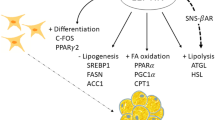Abstract
In addition to regulate body growth and development process, growth hormone (GH) also involved in lipid metabolism, decreasing fat mass and improving lipolysis. To normal mice, GH could reduce their fat content, but events turned uncertain coming to the pattern of feeding high-fat-diet. In order to investigate the role of GH in adipogenesis of mice with high-fat-diet, the high-fat-diet feeding mice were randomly assigned into three groups and treated with recombinant human growth hormone (rhGH) and the somatostatin analogue octreotide respectively. Results demonstrated that both rhGH and octreotide could reduce the body weight but the trends diminished in the end. HDL-C level was increased in octreotide treated groups but the activity of lipase was increased significantly in both two groups. RhGH remarkable increased the expression of SOCS2, FAS (P < 0.01) and SREBP-1c (P < 0.05), decreased the expression of SOCS1, SOCS3 (P < 0.05) and HSL (P < 0.01) in subcutaneous fat mass. In visceral fat tissue, all genes were increased except SOCS2 (P < 0.01), at the same time the visceral fat mass was decreased. The protein phosphorylation of JAK2 and STAT5 which were treated with octreotide were increased in subcutaneous fat, visceral fat and liver (P < 0.01) and were increased significant in visceral fat by rhGH treated (P < 0.01). In liver, only JAK2 protein phosphorylation was raised (P < 0.01). In conclusion, rhGH and octreotide could decrease the whole body mass before 6 days; the trend was weaken in later period with high-fat-diet. RhGH could increase the subcutaneous fat mass and reduce the visceral fat mass, and SOCS2 might be involved in regulation of the mechanism through JAK2/STAT5 signaling pathway.






Similar content being viewed by others
References
Lichanska AM, Waters MJ (2008) How growth hormone controls growth, obesity and sexual dimorphism. Trends Genet 24(1):41–47
Krebs DL, Hilton DJ (2001) SOCS proteins: negative regulators of cytokine signaling. Stem Cells 19(5):378–387
Nicola NA, Greenhalgh CJ (2000) The suppressors of cytokine signaling (SOCS) proteins: important feedback inhibitors of cytokine action. Exp Hematol 28(10):1105–1112
Gylvin T et al (2009) Functional SOCS1 polymorphisms are associated with variation in obesity in whites. Diabetes Obes Metab 11(3):196–203
Sabio G et al (2008) A stress signaling pathway in adipose tissue regulates hepatic insulin resistance. Science 322(5907):1539–1543
Metcalf D et al (2000) Gigantism in mice lacking suppressor of cytokine signalling-2. Nature 405(6790):1069–1073
Tollet-Egnell P et al (1999) Growth hormone regulation of SOCS-2, SOCS-3, and CIS messenger ribonucleic acid expression in the rat. Endocrinology 140(8):3693–3704
Jorgensen JOL et al (2006) GH receptor signaling in skeletal muscle and adipose tissue in human subjects following exposure to an intravenous GH bolus. Am J Physiol Endocrinol Metab 291(5):E899–E905
Greenhalgh CJ et al (2002) Biological evidence that SOCS-2 can act either as an enhancer or suppressor of growth hormone signaling. J Biol Chem 277(43):40181–40184
Studzinski ALM et al (2009) SOCS1 and SOCS3 are the main negative modulators of the somatotrophic axis in liver of homozygous GH-transgenic zebrafish (Danio rerio). Gen Comp Endocrinol 161(1):67–72
Slingerland LI et al (2008) Growth hormone excess and the effect of octreotide in cats with diabetes mellitus. Domest Anim Endocrinol 35(4):352–361
Linlin Z, Xingjia Y, Hui W (2005) Study on change of GH/IGF-I axis in diet-induced male obese rats. China Public Health 21(3):269–270
Greenhalgh CJ et al (2002) Growth enhancement in suppressor of cytokine signaling 2 (SOCS-2)-deficient mice is dependent on signal transducer and activator of transcription 5b (STAT5b). Mol Endocrinol 16(6):1394–1406
Flores-Morales A et al (2006) Negative regulation of growth hormone receptor signaling. Mol Endocrinol 20(2):241–253
Greenhalgh CJ et al (2005) SOCS2 negatively regulates growth hormone action in vitro and in vivo. J Clin Investig 115(2):397–406
Karavitaki N, Botusan I, Radian S et al (2005) The value of an acute octreotide suppression test in predicting long-term responses to depot somatostatin analogues in patients with active acromegaly. Clin Endocrinol 62(3):282–288
Conflict of interest
The authors declare no conflict of interest.
Author information
Authors and Affiliations
Corresponding author
Additional information
Hai Li Yang, Min Feng, Xiao Tan, and Guo Yong Yan contributed equally to this work.
Rights and permissions
About this article
Cite this article
Yang, H.L., Feng, M., Tan, X. et al. The role of SOCS2 in recombinant human growth hormone (rhGH) regulating lipid metabolism in high-fat-diet-induced obesity mice. Mol Biol Rep 40, 2319–2326 (2013). https://doi.org/10.1007/s11033-012-2313-5
Received:
Accepted:
Published:
Issue Date:
DOI: https://doi.org/10.1007/s11033-012-2313-5




